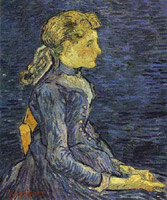page2 |
 |
 |
Marcel
Duchamp: Armory Show Lecture, 1963
recorded
by Richard N. Miller
Now, we go back
to the Impressionists.
Monet. Claude Monet was represented by five canvasses in the Armory
Show. This first one, Boardwalk at Trouville, 1870, when Trouville
was the Atlantic City of France, is an early attempt at Impressionism,
since the name “Impressionism” was coined only four years
later in 1874. And we have another Monet, entirely different. This
one is a Water Lily Pool, on the contrary, dated 1904, much
later, and is one of a series of water lily murals, which link Monet
with the birth of abstraction. The two Monets that you saw were in
the 1913 Show.
| click
to enlarge |
 |
| Figure
9 |
|
Georges
Seurat, Les Poseuses (The Models),1888 |
Seurat. Georges Seurat, in his too-short life - he died at age 32
- achieved a very important revolution with Pointillism, which was
his personal reaction to Impressionism. This beautiful version of Les
Poseuses (Fig. 9) of 1888, shows his very unique contribution
to the technique of Neo-Impressionism. A large canvas of the same
subject, Les Poseuses, is in the Barnes Foundation in Merion,
Pennsylvania.
Cross. Henri-Edmond Cross was with Seurat and Paul Signac at the
origins of Pointillism, the art movement that succeeded Impressionism
around 1880. This painting, called Clearing (Fig. 10)
of 1906-7, was in the Armory Show, and is a perfect illustration of
the theories of Pointillism, based on the scientific studies of Chevreuil.
Simultaneous contrast of colors which also influenced Delauney a few
years later, around 1912.
Toulouse-Lautrec. (I think we have it upstairs, I think) Toulouse-Lautrec
is less known for his oil paintings than for his posters. Nevertheless,
with paintings such as this one, called Red-haired Woman Seated
in Garden (Fig. 11) in 1889, he belonged to the
Impressionist group. This painting was in the original show, and
is also included in the anniversary show. (I saw it last night, hmm.)
Gauguin. Gauguin. Paul Gauguin brought back this oil from his first
trip to Tahiti. It’s called Mata Mua (Fig. 12),
which in Tahitian dialect means “in open times.”
It was shown at the important Gauguin exhibition at the Durand-Ruel
Gallery in Paris in 1893, when Gauguin was 45, already. As you know,
he died in miserable conditions during his second stay in Tahiti in
1903.
 |
 |
|
| Figure
10 |
Figure
11 |
Figure
12 |
| Henri-Edmond
Cross. The Clearing, c. 1906/07 |
Henri
de Toulouse-Lautrec, Red-Haired Woman Sitting in Conservatory,
1889, private collection |
Paul
Gauguin, Mata Mua, 1892
|
And van Gogh. Van Gogh. Of the 14 paintings that Van Gogh had in
the 1913 show, five important ones are in the anniversary show, upstairs.
This one, called Hills at Arles, from the Thannhauser
Collection was painted in 1889 at Arles or at St. Remy, I can’t
be sure. When van Gogh was very sick in the hospital at St. Remy.
I show you now another landscape very much like this one. Olive
Trees at St. Remy, painted in the same year, 1889. Very
luminous expression and all - almost the same thing. In the following
year, 1890, van Gogh went to live his last month in Auvers, a small
town near Paris, where he painted several portraits of young girls
like this one, Mademoiselle Ravoux (Fig. 13), June
1890, which is included in the anniversary show. Van Gogh died a
month later. Incidentally, this last painting used to belong to Katherine
Dreier, who lent it to the Armory Show, and it is now in the Cleveland
Museum of Art.
And now we come to Cézanne. Paul Cézanne. Woman with a Rosary
(Fig. 14). It was in the Show of 1913. Cézanne
painted this important portrait at the end of his life in about 1903,
probably in Aix [en-Provence]. In 1904-1905, the Salon d’Automne
and the Independents gave him a very important one-man show. He died
in 1906, before he had received a worldwide recognition.
Now we can do Ryder. Albert Ryder, a great, great painter, who came
from an American Cape Cod family, and lived for many years in New
York, on Washington Square and later, West 15th Street,
in a most modest and bohemian way, completely absorbed in and dedicated
to his inner vision. This Moonlight Marine (Fig. 15)
was in the original and is also in the present show. It’s one
of Ryder’s best-known themes, a typical expression of his position
as a forerunner of abstract art, as we understand it today. Very
abstract, isn’t it? You hardly see the boats. There are some
boats.
|
click images to enlarge
|
 |
 |
|
| Figure
13 |
Figure
14 |
Figure
15 |
|
Vincent
Van Gogh, Mademoiselle Ravoux, June 1890
|
Paul Cézanne, An Old Woman with a Rosary, 1900-04
|
Albert
Pinkham Ryder, Moonlight Marine, c. 1908, The Metropolitan
Museum of Art, New York |
 |
| Figure
16 |
| James
McNeill Whistler, The Little Rose of Lyme Regis, 1895.
Oil on canvas. The Museum of Fine Arts, Boston, MA, USA. |
Now, Whistler. James McNeill Whistler painted this portrait called
Little Rose of Lyme Regis (Fig. 16), which is,
I suppose, a small town in England. It was painted in 1895, and it
is considered as one of his finest achievements in quality, as compared
to most of his life-sized portraits. As we all know, Whistler lived
a great part of his life abroad, and became quite a big international
figure around the turn of the century.
>>
Next
page
1 2 3
4
|